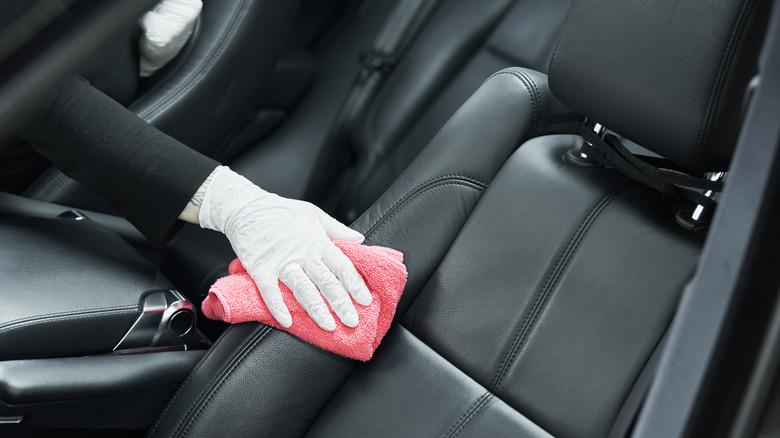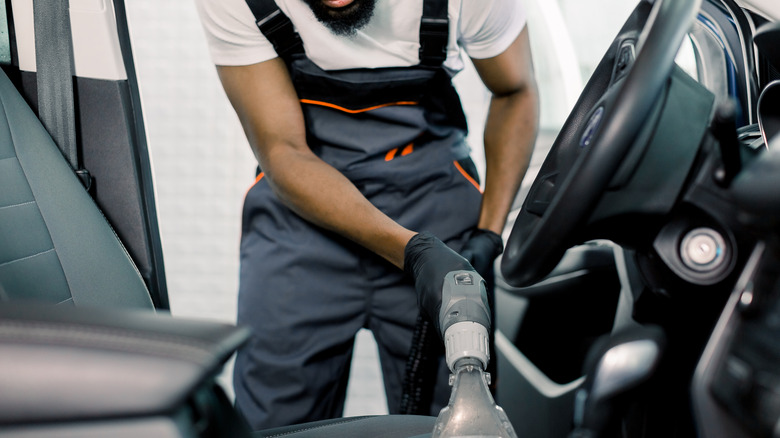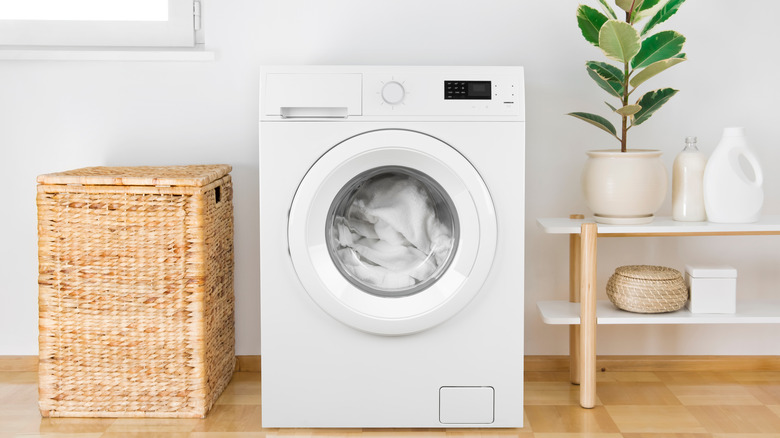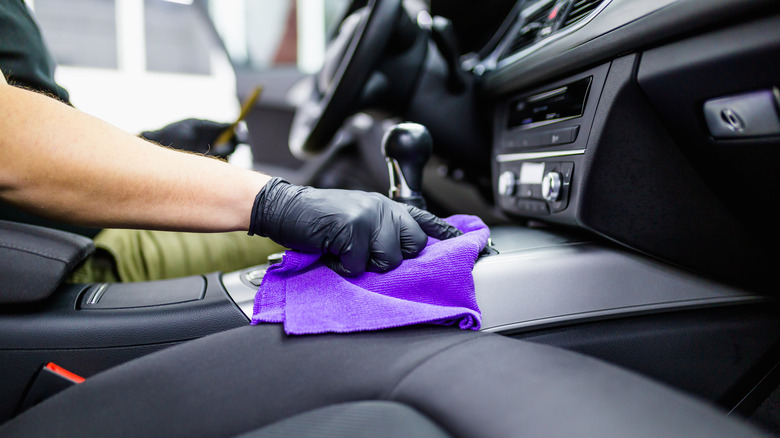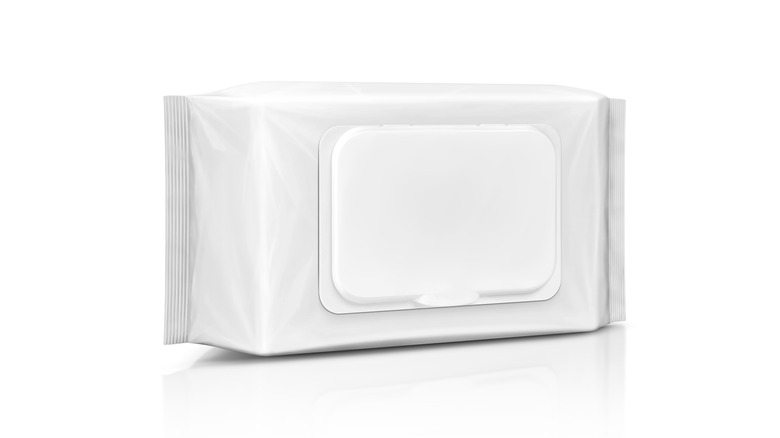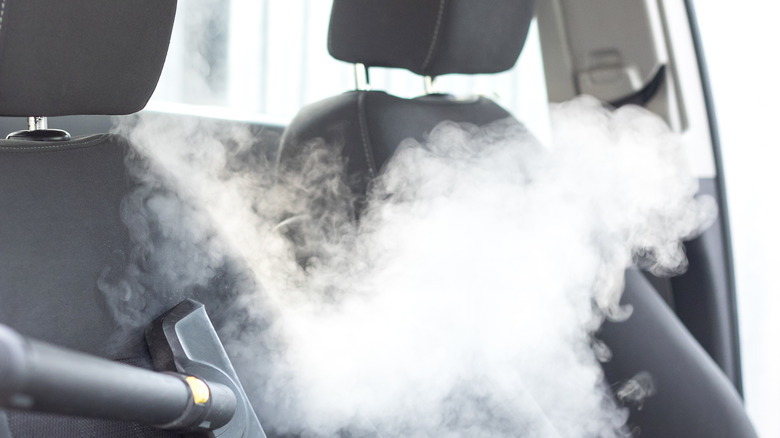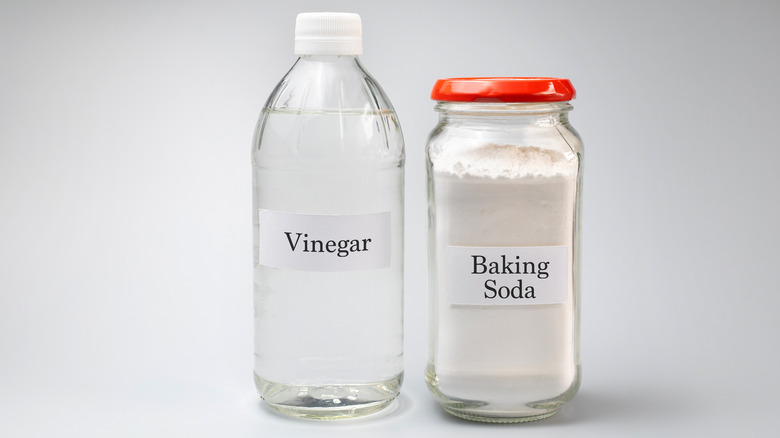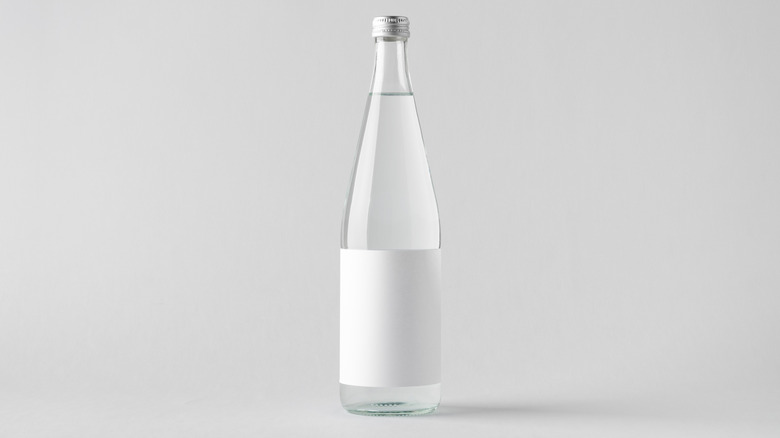8 Easiest Ways To Clean Car Seats
Cars are a huge necessity for many Americans. We use these vehicles daily, drive them through all kinds of weather, and often load them full of groceries, pets, children, and more. It's no surprise that our cars can get dirty due to this heavy use, especially on the seats. Car seats and car interiors don't tend to have the longevity of a good engine, either. According to The News Wheel, the average lifespan of a car interior is 10 years, yet the road average of a car is almost 12 years.
Unfortunately, keeping a seat pristine isn't as simple a Scotchgarding your furniture or cleaning it in your washing machine. It takes some effort to keep a car seat sparkling. Explore basic maintenance as we discuss the 8 easiest ways to clean a car seat. Learn how to wash them without damaging your upholstery, how to polish leather seats, and more handy car cleaning tips.
1. Sweep and vacuum your car seat
The simplest method to clean a car seat is to sweep or vacuum the debris. First, however, you'll need to pick up all your belongings and any trash that may have accumulated. For any parent that's ever removed a kid's car seat, this task alone can be significant. Once the area is clear, you can use a hand broom to sweep away smaller messes, but you'll want a vacuum for medium to heavy-duty jobs.
You can choose either a car-based vacuum that plugs into the car or a standard corded model that plugs into your house. Either way, the important idea is to choose a powerful model with attachments, according to Home Vacuum Zone. Small area attachments will allow you to access the cracks and crevices where crumbs are hiding and thoroughly clean fabric seams and floor pedals. Wide attachments are best for floors and larger seating areas.
2. Machine wash car seat covers
A washing machine can be a fantastic tool for those who have removable car seat covers. While most removable seat covers are machine washable, check the manufacturer's use and care guidelines just to be safe. Once you have the green light, prep your covers before you wash them. For stained covers, It Still Runs recommends treating the stain with a stain remover and then pre-soaking the cover in a washer filled with warm water for 15 to 20 minutes. If you don't have a stain remover handy, you can also pretreat it with laundry detergent.
Car seat covers can be washed in a normal cycle, but avoid the dryer. Instead, lay your covers on a flat surface to air dry or hang the covers on a clothesline. Make sure the covers are completely dry before moving them back to the car to avoid trapped moisture.
3. Dry clean car interiors
Not all car seat covers should get soaking wet. According to Home Explained, if your upholstery is made from a specialty fabric such as suede, you'll want to avoid cleaning techniques that can add too much moisture to the material. You'll need to dry-clean your car instead. Dry cleaning cloths such as Dryel will let you harness heat-activated chemicals to wipe down soiled upholstery, keeping your fabric safe.
Another popular method is to use a foaming upholstery cleaner like Woolite. Woolite foam often comes with a special fabric-safe brush attached to the nozzle that allows you to apply and wash simultaneously. You can scrub the car seat with the cleaner, let it dry, and vacuum away any residue. While these cleaners are designed for more delicate fabrics, it is still advised to try a test patch to make sure you don't cause any color or fabric damage.
4. Baby wipes clean everything
One of the most universally loved cleaners on the market is baby wipes. Parents will quickly tell you they can't live without them, but they're not only great in nurseries. They work in garages, too! These simple wipes work great for wiping up car seat spills and dusting the hard vinyl surfaces in your car. Even household professionals use baby wipes. In an interview with Martha Stewart, cleaning expert Bruce Barish of Ernest Winzer Cleaners recommends using these hand wipes for suede and leather spot cleaning.
Make sure to do a spot test first, of course, to ensure it doesn't leave a stain. "Make sure it's not drying in a darker shade and discoloring the garment," Barish warns. Once you confirm it's safe to use, gently rub the affected area. Use multiple wipes if necessary, but don't scrub too hard. It's a highly affordable and low-risk method.
5. Use leather and vinyl cleaners to wipe down seats
If you have vinyl or leather seats, you can use store-bought specialty cleaning solutions. Forbes Wheels reminds us that while car fabrics have improved in durability, materials such as leather will still require regular maintenance, such as conditioning. When it comes to conditioning their car seats, some people prefer premade wipes, others swear by a 2-step clean and condition method, and others prefer an all-in-one liquid cleaner approach. The important thing to remember is that proper conditioning will help protect leather, vinyl, and rubber beyond the removal of dirt. It will also keep it from cracking and peeling.
The range of specialty products includes both economic options and ultra-high-end professional products. The highest-end products might require additional skills to apply, so they are not recommended for the average home cleaner. Instead, consider options like the Chemical Guys Car Cleaner Kit or Mother's VLR.
6. Steam clean car seat fabric
If a wipedown isn't enough, steam cleaning your car seats is an excellent option for a heavy-duty intervention. As noted by Oh So Spotless, most fabric car seats can be steam cleaned, including those made from nylon, vinyl, and polyester. Genuine leather and faux leather are more challenging to treat with steam since they can shrink and become damaged. While it's possible to steam them, doing so isn't recommended for beginners.
Prepare the car for cleaning by emptying trash, vacuuming debris, and then spot-treating tough stains. When preparing your steam cleaner, make sure you have an upholstery attachment. Begin steaming, but remember this method is hot and wet. Avoid heating metal car parts to avoid burns and practice a top-to-bottom cleaning pattern to prevent kneeling on damp upholstery. You can switch out attachments and use a gentle brush for persistent stains, and wipe down excess water with a dry cloth.
7. Clean with vinegar and baking soda
Green product fans swear by vinegar and baking soda, which is also safe to use in your car. Beyond the simple joy of watching baking soda and vinegar bubble, you can also gain some serious deodorizing effects with this cleaning method. For most fabrics, you can sprinkle dry baking soda across the surface, let it sit, and then vacuum up both soda and odors, per The Christian Science Monitor.
You can also use a vinegar and baking soda combo to clean dirt and soiled upholstery, though you should not use it on leather. HomeViable instructs pouring 1/3 cup of baking soda into a small bowl, adding a dab of dish soap, and mixing in some warm water to create a paste. Afterward, add vinegar and stir until the paste becomes liquid enough to add to a spray bottle. Spray it on your car seat and scrub.
8. Remove stains with club soda
This method is handy for on-the-go cleanings and simple touch-ups. You probably don't drive around carrying specialty upholstery cleaner, but you might drive around town with club soda in your trunk. Ask any cleaning expert, and you'll know that carbonated water, specifically club soda, has long been a go-to fabric stain remover.
If you'd like to "kick it up a notch," DIYers have been experimenting with bubbly water cleaners for a while and have some additional ideas. According to Kitchn, one family tried cleaning with Lemon LaCroix thinking it would have the same effects as a club soda and lemon mixture. They had some success. Another cleaner upgraded a vinegar and Dawn dish soap recipe by adding club soda for its stain-fighting powers and was impressed with the results (via Inspired Housewife). So try these great tips for cleaning your car seats or invent your own. Your car seats will be spotless all year long.
